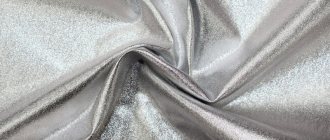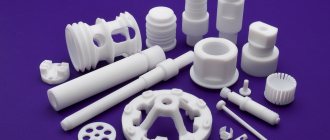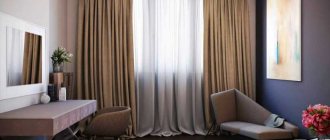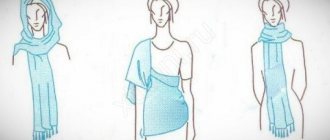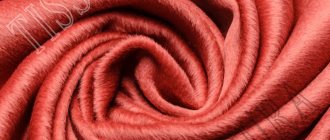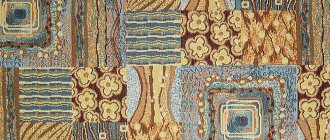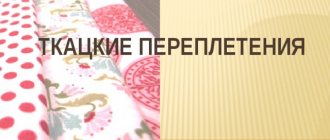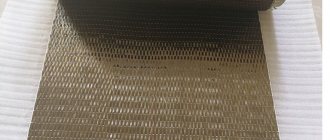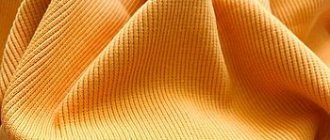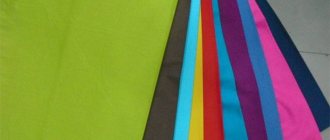Durable and soft polyamide fabric has been popular for a long time. It was nicknamed breathable because polyamides allow air to pass through well. It is used not only for sewing things, but also for industry. In the article we will describe the characteristics of the material, varieties and care rules.
Polyamide: material description
Many people are interested in what kind of fabric this is – polyamide. It is produced from organic raw materials (oil, gas or coal) in several stages:
- Polymer synthesis - at this stage, caprolactam is extracted from benzene.
- Processing of caprolactam into polymer.
- Textile formation – polymers are formed into threads.
Inexperienced people may confuse polyester and polyamide, calling everything “synthetic.” So what is the difference between them? The difference is in the polymers used and the bonding of the fibers. Polyester allows air to pass through better, but gets wet more. But both types of synthetics have high strength, flexibility, resistance to wear and creasing, as well as the accumulation of static electricity. Synthetics today are not the same as the products they were 10 years ago. It can be added to natural fabrics and improve their properties, for example, reducing the tendency to wrinkle.
Interesting! Polyamide is stronger and more expensive than polyester.
Modern polyamide fiber is used in its pure form mainly for nylon tights. More often they are supplemented with other materials: wool, polyester, elastane, polyurethane.
Polyamide feels like cotton fabric. To distinguish real polyamide, pay attention to the electrification. If sparks appear when dressing, then you are holding real polyamide fabric in your hands.
The second way to check is ignition. If the fabric begins to melt without any aroma and a ball forms from the smoldering, then it is polyamide.
The third way to identify tissue is more laboratory - immersion in mineral acid with a high concentration. This polyamide fabric is completely dissolvable.
LiveInternetLiveInternet
YARN WITH POLYAMIDE
Polyamide is a whole group of different synthetic fibers, including nylon, nylon, and silone. Polyamide fibers are obtained by processing various organic raw materials - oil, natural gas, coal. The main properties of products made from polyamides: high dimensional stability and strength, low light fastness, high electrification, as well as good colorability, high wear resistance, low pilling.
polyamide with lurex
acrylic polyamide elastane
Polyamide fabrics were one of the first synthetic fabrics to enter the market; The popular name “synthetics” for a long time referred exclusively to them. Everyone knows the disadvantages of products with a large amount of nylon, nylon and other polyamide fibers, including the tendency to accumulate static electricity, “stuffiness” and intolerance to prolonged exposure to light. That is why 100% polyamide yarn is less often found on sale than others. But the shortcomings are more than compensated for by high strength and dimensional stability. It is these qualities that make mixtures with polyamide additives suitable for knitting things that require increased strength and wear resistance (this can be women's and men's sweaters, children's clothes, scarves, gloves, socks and much more). Such properties of polyamide make it a welcome guest in any yarn - with viscose, acrylic and various types of wool. This is done in order to give the product the resulting strength while maintaining the properties of natural fiber. The properties of each specific yarn depend on the percentage of polyamide in it.
Yarn 50% cotton 50% polyamide, which is widely used, neutralizes the negative properties and successfully combines the positive characteristics of both of these materials. Cotton gives the yarn good breathability, and polyamide gives it elasticity and strength. Cotton polyamide yarn is used for making casual and festive clothing, including many small details. Therefore, on yarn packages you can often see the inscription “polyamide cotton”.
Polyamide is often mixed with elastane, which is also not used in its pure form in products. The composition of 80% polyamide 20% elastane allows you to create a yarn that is strong, but very elastic. Due to elastane, the thread can increase several times its original length, so things made from it can stretch greatly without the risk of tearing. In the 90s, there was a real revolution in the production of synthetic fibers, including polyamide. In new developments, the negative properties of these fibers have been eliminated or minimized, and in some properties, synthetic fibers have “overtaken” natural ones. For example, modern polyamide microfibers provide better air exchange than cotton.
Products made from polyamide should be washed in a gentle mode, at a temperature not exceeding 40 degrees. It should be remembered that you cannot rinse things made of polyamide with softening agents: this may cause them to lose their water-repellent properties.
Based on materials from sites:
https://www.narodko.ru
https://polyamides.rf
https://www.comazo.ru
Series of messages "yarn":
Part 1 - MERSERIZED COTTON Part 2 - VISCOSE Part 3 - ACRYLIC Part 4 - YARN WITH LYCRA Part 5 - YARN WITH POLYAMIDE
Features of the composition
Polyamide has the following properties: matte rough or glossy smooth surface. Every texture has a positive and a negative.
pros
Modern polyamide material has many positive features:
- the highest strength - the thread can withstand a load of up to 1.5 kg. with a thickness slightly larger than a human hair;
- weightlessness - clothes made from the material are very light;
- good maintenance of the shape of the product - the density of polyamide allows things not to wrinkle and look well-groomed after folded;
- polyamide fire-resistant fabric does not ignite in fires, it can only melt at elevated degrees;
- perfectly allows air flow, allowing you to cool the body in hot weather;
- the fabric is gentle to the body, pleasant to touch;
- can be painted in any shade;
- polyamide is one of the materials that stretches well, allowing you to stretch the item to different body types;
- Manufacturers often say that a material that does not require special care is polyamide. It is enough to wash it in a washing machine with a powder that matches the color of the fabric and nothing will shrink;
- good reflection of light rays;
- do not deteriorate from thermal oxidizers;
- Polyamide dyed thread will not fade in the sun, from fungus and sea salt. Also, it does not rub during wear, even on bends;
- the fabric is water-repellent and quick-drying, so it is often added for winter and mid-season outerwear.
Minuses
Despite many advantages, there are negative properties:
- does not retain heat - due to its good throughput, the wind quickly blows away the heat. For winter clothes this is a negative property, and for summer clothes it is a positive property;
- at high temperatures from 40C it becomes hard and can break;
- fibers do not absorb moisture, which is why they become highly electrified. Moreover, static electricity accumulates over time and can “spark” when getting dressed;
- if you want to alter clothes or home textiles yourself, the fabric will crumble when cutting;
- instantly absorbs greasy and sweaty stains that are difficult to remove;
- may cause allergies in people with sensitive skin.
The material has many more advantages than disadvantages. Therefore, the material is very popular and is used for all seasons of the year in various forms.
Disadvantages of polyamide fabric
The disadvantages include:
- • Low moisture absorption.
- • Due to the fact that the fiber has high thermal conductivity, clothes made from it will be cold in winter and hot in summer.
- • There is no way to remove grease stains.
- • Unsuitable for use at temperatures above 40 degrees. At this moment, breaking and crumbling occurs.
- • Low hygroscopicity leads to increased electrification.
- • Synthetics can cause allergic skin rashes.
Types of polyamide fabric
Various questions are received about the types of polyamide fabric. Many people are surprised, what kind of canvas is this, which has 7 different types? Now we will talk about each type separately.
Nylon
This is the original and still in demand type of matter. It is used to produce underwear, tights and is added to textile and knitwear products (socks, blouses, sweaters). It is beautiful, light and does not take long to dry even in an unventilated area. But when wet, it can stretch, and also causes allergic reactions in people with delicate skin.
Caring for nylon is not difficult; you can use a washing machine with cold or warm water; hot water will ruin the fabric. The fabric does not wrinkle, so there is no need to iron it. But if the item was dried in a crumpled state, then you can walk over it with a warm iron. Nylon fiber is often added to cotton and satin to make fabrics lighter, cheaper and more resilient.
Jordan
It can be used in any clothes for adults and in clothes for children. The fabric is very soft, smooth, has a pleasant shimmer, repels liquids and conducts air currents. A variety of outerwear is made from fabric fabric, from off-season windbreakers to winter overalls.
Elastane
Used to add to other materials. It allows fabrics to stretch up to 8 times with a return to their original appearance, and become not susceptible to fading in the sun, damage from greasy and sweaty stains, sea water, and cosmetics.
Velsoft
Another type of polyamide fabric with high strength and hairiness. She is also not prone to fumbling, breathes and is very warm. It has the appearance of a voluminous fleecy material on which pellets do not form. After washing, the shape of the product is not lost, the size does not decrease and the color is not washed out. It can be one color or with a variety of images. The material is very soft, therefore it is in demand for home textiles (blankets, towels, bedspreads) and everyday adult and children's clothing.
Polyamide filter fabric
Very dense and difficult to tear compared to natural fabrics. It does not deteriorate from chemical reagents and stores solid, liquid and gaseous particles, preventing them from getting on the skin.
Taslan
Used for sewing clothes for adults. It weighs more than nylon, but is stronger and has excellent breathability due to its porous structure.
Nylon, tactel
Very famous types of polyamide from which hosiery products are made. Very durable and lightweight.
Anid
Anide is a type of nylon with better heat retention and coloring properties.
Types of yarn and its properties.
Hello, dear Masters and no less respected Visitors!
Knitting is now one of the most popular types of creativity. Here at the Fair (and not only) there are many, many different knitted items. Made from cotton, linen, wool... These names at least tell us something. But what about such “tricky” names as acrylic, microfiber, boucle and others? Why are they good, or maybe bad?
I am publishing for your attention types of yarn and their properties.
Cotton Thanks to its unusually rich range of colors and varied fiber quality (shiny, matte, variegated), cotton yarn is used for knitting with almost any pattern and undoubtedly occupies one of the leading places in modern fashion. The quality of cotton fibers is: regular cotton thread, shiny cotton thread, melange cotton thread, silky cotton thread. The main properties of cotton include hygiene, resistance to alkali (or, simply, to washing); Cotton “breathes” (permeates air well) and easily absorbs moisture. Cotton is comfortable and pleasant to wear, soft and resistant to abrasion and tearing, and easy to care for. Cotton dyes well and practically does not fade. In direct sunlight, cotton becomes less durable and therefore requires protection. Comparing it with other plant fibers, it can be noted that the warming effect of cotton is higher than that of flax. Cotton is stronger than wool, although less durable than linen or silk. The product is easy to wash if pre-soaked. However, cotton products shrink a lot and take a long time to dry.
Fancy yarn This is a melange yarn made by mixing natural fibers with synthetic metallized threads of various textures (bouclé, “bumps”, etc.). Fancy yarn is usually used for knitting exquisite patterns.
Shiny Yarn A composition of viscose and acrylic yarns added to the base yarn gives it a golden or silvery effect. /shiny threads, lurex, viscose threads/
Viscose The properties of viscose yarn include shine, elasticity, softness and breathability. However, the big disadvantage of knitting with such yarn is that the knitted fabric stretches greatly. This is the very first artificial fiber. High color intensity allows you to create products in bright colors. In knitting yarn, viscose is included in a blend of fibers, usually with cotton, as well as with wool and mohair, while improving the positive qualities of the latter. It is best to wash viscose items by hand using a mild detergent.
Fancy yarn Fancy yarn is the name given to specially spun yarn, yarn obtained by mixing fibers of different color and quality, as well as yarn made using a special technology. Natural fibers are often mixed with synthetic and metallized yarns to produce fancy yarns.
Linen is the strongest yarn. Products made from linen absorb moisture more easily and dry more easily than knitted products made from cotton or wool. Linen does not shrink at high temperatures and does not shrink. In hot and very hot weather, linen products are preferable to cotton ones. Linen is difficult to dye or bleach. Therefore, the most common yarn is made from flax, in natural, gray-beige colors.
Bamboo thread is a bamboo fiber with a natural luster, softer than cotton and similar in quality to silk. Bamboo is versatile. Bamboo fibers are even added to yarn thread. A knitted product made from bamboo yarn perfectly absorbs moisture (3 times more than 100% cotton), gives the body a gentle feeling, and does not lose its original color. Bamboo fiber, from which threads and fabrics are obtained, is very durable. Bamboo fabric is non-irritating and has natural antimicrobial properties, containing an ingredient that prevents the growth of bacteria. Bamboo material has a slight shine, so it looks more luxurious than cotton. Bamboo fiber has excellent ventilation ability, allowing the skin to breathe freely. Retains its unique properties even after repeated washing and drying. Products based on bamboo fiber are suitable for people suffering from allergies and asthma. When knitting from bamboo yarn or yarn with the addition of bamboo, it is necessary to take into account that bamboo thread is similar in properties to viscose. Therefore, a knitted item can stretch greatly both in length and width. If the calculation of the loops and the number of knitting needles were chosen correctly, then you will get a magnificent thing!
Silk. Silk thread holds heat well. There are practically no pellets formed on it. It is quite strong, does not deform and paints beautifully. Silk products absorb moisture well. For knitting, mainly mixed types of silk yarn are used.
Rayon. Artificial silk dries quickly, but is not durable enough. In its pure form it is practically not used for knitting. Added to other types of yarn to improve their characteristics.
Wool yarn is a natural material, obtained from the sheared wool of sheep since ancient times. Such wool retains heat well, neutralizes the difference between body temperature and air temperature, and is hygroscopic. Wool yarn is ideal for knitting smooth, textured and multi-colored patterns. According to its characteristics, wool yarn is lighter than vegetable yarn and more elastic. Retains heat better. Does not get wet as quickly in a humid environment as cotton, but is less durable. The disadvantages of wool yarn include its matting and the formation of pellets on it during friction. Moreover, the weaker the yarn is twisted, the more pronounced these shortcomings are. In order to get rid of them, as well as to give the yarn other positive characteristics, artificial or plant fiber is added to wool yarn. The example of wool yarn and acrylic has already become a classic example. Moreover, most often, such yarn becomes cheaper. When washing wool products, you should take into account such a feature as stretching (especially when wet).
Merino wool. The wool is very soft. Other types of fibers are rarely added to it, and if they are added, it is only to make wool cheaper, and not to improve its quality. It is ideal for children's things, because... does not irritate the skin. Merino wool is more expensive than regular wool.
Mohair is a wool yarn with long fluffy fibers. It is used only for knitting. Mohair makes airy, warm products. Very often I call any fluffy yarn mohair, but this is not so. There is “mohair” made from synthetic threads. Orenburg down scarves are real mohair. Mohair wool is quite expensive and is most often spun with wool or rayon thread. Mohair dyes well. Easy to clean from dirt. Wash mohair very carefully so as not to lose its “fluffiness”.
Angora. Angora wool comes from Angora rabbits. In its pure form, this wool is practically never used. Firstly, because it is quite expensive, and secondly, because it is completely inelastic. But angora is simply ideal when combined with wool, merino wool or acrylic. The fur of the Angora rabbit is very fluffy, soft and warm.
Camel's wool. There are two types of camels: Bactrian and Vicuna. The wool of the Bactrian camel is less valuable than its South American counterpart, and it is also a little fragile. Camel wool is practically not bleached and therefore comes in either a natural color or a dark or black color. Vicuna camel wool is the queen of wool. The Vicuna's coat is ready for shearing only once a year, when its coat is at its thinnest. The wool of this camel is not the most expensive.
Cashmere. The yarn is very light, warm and soft, but it is too susceptible to friction and pilling, so you will hardly find pure cashmere. Typically, it is mixed with wool fiber in different proportions.
Alpacas. Alpaca wool is more valuable. Currently, llama and alpaca wool are divided into 22 color shades. Starting from pure white, then beige, silver, brown and black. Due to the fact that the individual wool fibers are long, alpaca wool does not mat and practically does not form pellets. The yarn made from this wool is denser, and therefore the fabric often “hangs” in the product. There is one peculiarity of storing alpaca wool. She can't stand mothballs. Therefore, I use natural remedies against moths, lavender, tobacco or cedar. Alpaca yarn is usually used in its pure form.
Acrylic can be dyed quite well, this allows you to obtain yarn of a variety of rich, bright colors. Products made from acrylic yarn are comfortable to wear, retain their attractive appearance longer, and are less likely to fall off.
Polyacrylic yarn also refers to synthetic types of yarn. In its pure form it is very rarely used for knitting, but is well suited as an additive for other types of yarn. Polyacrylic fibers are more elastic and increase the wear resistance and strength of the thread. Polyacrylic yarn is a pliable and soft material that perfectly imitates wool and has hypoallergenic qualities. Items made of wool with the addition of polyacrylic should be washed carefully, at a temperature not exceeding 35 degrees. The disadvantages of polycaryl include its ability to accumulate static electricity in large volumes. At the same time, products made from polyacrylic are very warm, since the material is fluffy and can allow a lot of air to pass through it; they do not fit tightly to the body.
Microfiber is a new generation yarn, velvety, very durable, breathable. Made from either 100% polyester or cotton blend. Microfiber was first made in Japan. These fibers are ten times thinner than natural silk fibers, thirty times thinner than cotton fibers, forty times thinner than natural wool fibers, and one hundred times thinner than human hair fibers.
Nylon and lycra - as a rule, are not used in their pure form. Used in mixtures with natural and synthetic yarns to give them elasticity, as well as to hold hairs together (mohair + nylon)
Polyester - used in mixtures with any materials to increase the strength of the yarn, but is also found in its pure form (for example: plush yarn, ribbon yarn).
Thank you all for your attention!
Application
Many people are interested in what polyamide is in clothing and what health hazards it can cause. There may be harm to health if the fabric causes allergic reactions. In other cases, no harm is caused to health, otherwise its production and use in clothing would be prohibited. On the contrary, polyamide is very widely used in various fields. For example, for sewing everyday items (socks, sweaters, sweaters, overalls, trousers, underwear).
The material is also often used in the manufacture of home textiles, lace, yarn, thermal underwear, various shoes, wallets, briefcases, artificial fur, business card holders, bags, laces, ropes, rubber tires, carpets, winter and demi-season outerwear.
Polyamide fabric is used to make workwear for various specialists: builders, doctors, oil workers, firefighters, tourists, athletes, actors, etc. They even make fishing nets and gear from it, which are very durable and reliable.
Features of caring for polyamide clothing
In order for clothes made of polyamide to serve for a long time, it is necessary to use a delicate washing mode with a temperature not exceeding 40C. After all, elevated temperatures provoke creases and cracking. The spinning and drying provided by the machine are too strong for the fabric, so they are excluded. Strong manual spinning is also not acceptable. Wet items are hung on a simple hanger and waited to dry completely.
Usually the material does not wrinkle at all and there is no need for ironing. But if the need arises, then when ironing the iron should be in a non-steam and warm mode not exceeding 40C.
Important! The steamer will completely damage polyamide clothing and textiles, so it should not be used.
Look at photo examples of the use of polyamide fabric in casual and outerwear, as well as in home textiles below.
1 of 27
Synthetic fibers are fibers obtained by synthesizing polymers consisting of natural low-molecular substances (C, H, O, N, etc.) as a result of a polymerization or polycondensation reaction. Polymers are synthesized from oil, gas and coal processing products (benzene, phenol, ethylene, acetylene, ammonia, hydrocyanic acid), which are produced in huge quantities at chemical plants. By changing the composition of the starting products, it is possible to vary the structure and properties of synthetic polymers and the fibers obtained from them. The most common among them are: polyamide, polypropylene, polyester and polyurethane. Acrylic
- synthetic fiber, in many properties close to wool (although there are also cotton-like modifications), resistant to light and other atmospheric agents, acids, weak alkalis, and organic solvents. Acrylic fibers are easy to dye, they are comfortable and warm, and are not susceptible to moths. Acrylic has high shrinkage, so it is used to produce high-volume yarn. Disadvantages include abrasion, pilling (albeit less than wool), electrification, allergenicity, low breathability, loss of dimensional stability. Most of the shortcomings of the original acrylic can be reduced with special impregnations. Main trade names: nitron (produced in the USSR), orlon, acrylan (USA), cashmilon (Japan), dralon (Germany), curtel (England).
Dralon
— acrylic fiber, ultra-strong and resistant to various types of influences. Yarn containing dralon is soft, shape-resistant, retains heat, is easy to wash, and dries quickly.
Nitron
- a type of acrylic fiber, which in appearance, softness, volume and thermal conductivity is close to wool fiber. Nitron has fairly high strength, elasticity, and heat resistance. It is resistant to mineral acids and alkalis. Compared to other natural and chemical fibers, it has the highest resistance to light. The disadvantages of nitron include low hygroscopicity, poor paintability and low abrasion resistance. Nitron is used for the manufacture of knitted products, artificial fur, and in blended yarns with wool, viscose and other fibers - for the manufacture of fabrics.
Polyamide
- characterized by high tensile strength and excellent wear resistance. Resistant to the action of many chemical reagents, resists biochemical influences well, and can be painted with many dyes. It has high dimensional stability, does not lose shape during wet and dry use, and does not require special care. Disadvantages - high electrification, instability to light, low hygienic properties. Main trade names: nylon (Russia), dederon, perlon (Germany), silon (Czech Republic), stilon (Poland), nylon, tactel (USA), lilion (Italy). Nylon is a durable polyamide fiber, which is second only to flax fibers in strength. The fiber is very elastic and resistant to alkalis. The disadvantages are low hygroscopicity (although this determines the widespread use of nylon in the manufacture of raincoats), low heat resistance, low resistance to light, pillability and electrification.
Tactel
— high-quality polyamide fiber, which provides the product with increased comfort, wear resistance, and resistance to peeling. Yarn with the inclusion of tactel is soft, breathable, does not electrify, dries quickly, and is easy to care for.
Nylon
– another high-strength polyamide fiber, used in various types of yarn to increase strength, wear resistance, and reduce shrinkage after washing. It is used for the production of products that require strength and reliability in operation: sportswear, swimwear, lingerie, hosiery. Recently, nylon is increasingly used in the production of yarn: adding nylon to mohair, wool or acrylic in an amount of only 10–15% does not in any way impair the hygienic properties of natural fibers, but significantly increases their elasticity, strength and resistance to deformation.
Polyester
- synthetic fiber from the polyester group. Initially, polyester had many disadvantages: despite its high strength, it was rigid, highly electrified, and low hygroscopic. Now polyester for the textile industry is produced in the form of microfibers. This type of fiber in yarn is usually mixed with wool, cotton, linen and viscose, which gives the products increased wear resistance and elasticity in addition to all the positive qualities of natural fiber. The yarn is durable, breathable, retains heat, soft and pleasant to the touch. Clothes for almost any purpose are produced from pure polyester microfiber, as well as from yarns with its inclusions: elegant dresses, suits, swimsuits, underwear, sportswear, jackets.
Microfiber, microfiber (Microfiber)
- the finest synthetic fiber made of polyester or polyamide (and recently microfibers from viscose and acrylic have appeared) with a thickness of only 6–9 microns. Polyester microfiber has low hygroscopicity and low wettability; being woven into fabric they form a very dense structure, that is, the product acquires water-repellent properties without additional processing, which makes the fabric heavier. The same dense structure contributes to wind protection and thermal insulation - the clothing is absolutely windproof and warms well. At the same time, due to the thinness of the microfiber, many airy, open cavities are created inside the fabric, so sweat can easily be absorbed and evaporated into such fabric, and the fabric itself breathes and dries quickly.
Lavsan (PET)
- polyester fiber, which is not inferior in strength to polyamide, but loses almost no strength when wet and can withstand heating up to 180°C. In terms of heat-protective properties, wrinkle resistance and elasticity, lavsan is close to wool, and in elasticity it surpasses it. Folds, pleats and corrugations are well preserved on lavsan products after washing and cleaning. Lavsan is resistant to light, chemically resistant to acids and alkalis. The disadvantages of lavsan include low hygroscopicity, high electrification, and poor paintability. In blended yarns with wool, cotton and other fibers, lavsan is used for the production of fabrics, knitwear, and artificial fur. Dacron is used to produce bulky yarn for outer knitwear.
Polypropylene (PP)
- a fiber with good physical, mechanical and chemical properties, characterized by high strength, resistance to repeated bending, elasticity, and lightness. The thermal conductivity of polypropylene fibers is low, so products made from them have heat-shielding properties. The disadvantages of these fibers include low heat and light resistance and poor dyeability. Polypropylene fiber is used to make knitting threads, and mixed with cotton, wool and viscose fiber to make fabrics.
Elastan
- artificial elastic fiber made of polyurethane, in the form of monofilament. It has very high elasticity, elongation up to 800%. Elastane is more resistant to friction and light than rubber, and is resistant to sweat, grease, dry cleaning and cosmetics. Elastane is used with yarns and fabrics in very small quantities - just 1-3% elastane dramatically changes the properties of the fabric or yarn. Also known as lycra (USA), spandex (Canada, Korea).
